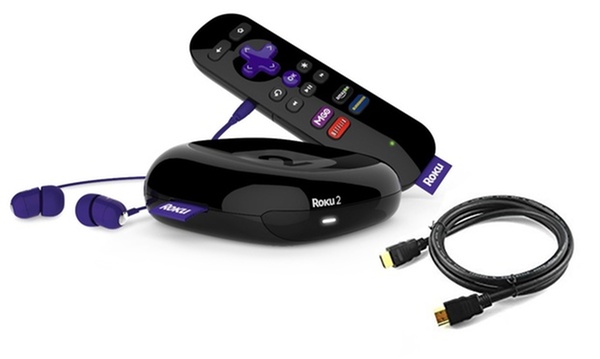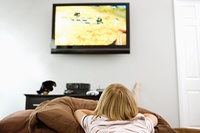TV Buying Guide
TVs have come a long way from the rabbit-eared boxes in 1950s living rooms. Models today can come with built-in WiFi, streaming apps, USB ports, and many other features.
All those innovations raise lots of questions when shopping for a new TV. How big should mine be? What does 1080p actually mean? How does 3D work? With this TV buying guide, you’ll be better prepared on these topics and others when looking for the main piece in your home-entertainment setup.
Screen Sizes
How to Measure a TV
The number in inches that’s attached to a TV’s description is its corner-to-corner measurement. While this is one of the chief ways manufacturers and stores sort TVs, it’s not the only number that counts. Make sure you take width, height, depth, and other dimensions—such as wall-mount measurements—into account when picking yours.
Tip: Lots of TV sizes are listed by “class.” A 32” class TV, for example, might actually only have a screen that measures 31.5” diagonally. The difference usually isn’t big enough to change the viewing experience.
What Size TV Should I Get?
Generally, bigger is better. Picture resolution on most HDTVs is so fine that it’s nearly impossible to see individual pixels, even if you’re sitting up close. To determine exactly how big to go, some experts recommend calculating the field of view you’ll have from the couch (see formula below). The result will be the “ideal” size. If a 70-inch TV is just too burdensome for your living room (or your wallet), going down to something smaller should still give you a good view.
Display Lighting: LED vs. OLED
A TV’s screen requires a lighting source to generate its picture. Currently, two of the more popular screen-lighting technologies are LED and OLED. Here's a breakdown of the pros and cons of each:
| LED (Light-Emitting Diode) Panel | OLED (Organic Light-Emitting Diode) Panel | |
| Light Source | Low-energy LEDs | Materials inside produce colors when lit by an electrical current |
| Pros |
|
|
| Cons |
|
|
Picture Resolution
How detailed your TV’s screen will be depends on a handful of factors, but chief among them is resolution, which measures a display’s pixels. Generally, the more pixels packed into a display, the more detailed and smooth the images will be.
You’re likely to see one of three resolutions when shopping around for an HDTV: 720p, 1080p, or 4K/UHD. The below table briefly explains each resolution standard’s characteristics:
1080p vs. 720p vs. 4K/UHD: What’s It Mean?
| Resolution Standard | Also Known As | Number of Pixels | Where Can I See It? |
| 720p | Standard HD; HD | 1,049,088 | DVDs; most HD broadcasts on TV |
| 1080p | Full HD | 2,013,600 | Blu-ray discs; certain on-demand content (no over-air signals yet available) |
| 4K/UHD | Ultra-High Definition | 8,924,400 | Limited content from on-demand services, such as Netflix and Hulu Plus |
HD Standards: 720p and 1080p
You’re more likely to run into one of these standards when shopping, at least for the next few years. A good rule of thumb when choosing between the two: if you sit further than 10 feet from a TV that’s smaller than 50 inches, you likely won’t be able to tell any difference in resolution. Sit any closer or make the TV any larger, and more details will pop out with a 1080p picture.
Next-Level HD: 4K/UHD
This newer picture-resolution technology amps up the detail on screens by packing in four times the pixels of a 1080p full-HD screen. Again, you’ll need to factor in proximity and screen size to determine if you’ll be able to notice the lifelike detail 4K generates.
Curved Screens: What’s the Benefit?
Some newer HDTV models come with an unusual feature: a curved screen. So what are the benefits of having a concave display?
Everyone's Got a Good View
A curved screen offers an ideal viewing angle to people seated all around the room. Normally, a viewer at a sharp angle on the left or right of the TV will see a slightly warped version of the display, but with a curved screen, more of the display is presented directly to them, giving a better view.
Fewer Reflections
Curved displays can also help cut down on reflections, an important feature in rooms with a lot of sunlight.
Theater-Like Experience
A curved panel’s bent edges can help generate a visual that seems to envelop and surround the viewer, creating a more cinematic viewing experience.
Refresh Rates
Put simply, a TV’s refresh rate is a measure of how quickly the screen regenerates its images. Think of it like a futuristic flip book; the slower you flip (lower refresh rate), the choppier the movement is. Speed through it (higher refresh rate), and you start to see a smoother, more realistic moving image.
Not All Refresh Rates Are Created Equal
Some companies make their own screen-refreshing technologies to deliver a smoother picture. Samsung’s Clear Motion Rate, for example, analyzes the panel’s refresh rate, backlighting, and processing speed to generate a custom refresh number. Dig into the TV’s tech specs to find the actual refresh rate, or head to a store to see how it looks in person.
When It’s Useful
An episode of The Office doesn’t usually suffer from fast-paced motion blur. But an enhanced refresh rate really shines when watching sports and other action-packed sequences. Seeing a baseball player swinging the bat in 60Hz can be a dramatically different experience to viewing it in 120Hz.
3D TV: Common Questions and Answers
Do I really need glasses for 3D TV?
Yes, all 3D TVs currently require glasses to achieve their 3D effects. Most 3D TVs include a pair or two, but it’s a good idea to check the TV’s contents to make sure.
What about for regular, 2D programming?
Standard 2D content doesn’t require any glasses to watch, though it may require popcorn.
What’s the difference between active and passive 3D?
Active-3D glasses have lenses that, using battery power, actively shutter to block the image that’s coded for the opposite lens, leading to a cleaner overall picture.
Passive-3D glasses are more like the ones you’d get at a movie theater. Despite each lens not specifically shuttering with image coding, many people prefer passive glasses since their lenses don’t cause the images to warp when you turn your head or move to a different viewing angle.
Will everything on my 3D TV come through in 3D?
No. Only content that’s been filmed for 3D use will actually pop off the screen.
Where can I see 3D content?
Some Blu-ray movies are marked as being filmed in 3D, and some streaming services and cable providers, such as Netflix and Comcast Xfinity, offer select movies and programming in 3D.
Will it impact picture definition?
Active-3D TVs can work in up to 1080p full-HD resolution but are prone to showing what’s called crosstalk, in which a second, blurry image partially overlaps with the main one. A passive-3D TV avoids crosstalk, but its picture quality suffers a bit when 3D content is displayed.
Smart TV and WiFi
In general, Smart TVs bridge the gaps between computers, mobile devices, and TVs. You can stream movies and videos in apps, surf in full-fledged web browsers, and connect to peripheral devices such as phones and tablets to share their data and even their screens.
Apps and Programs
Many smart TVs today come equipped with smartphone-like interfaces that can be packed with apps. Some of these programs come built-in; many TVs come with popular streaming apps such as Netflix and YouTube right away, while other programs can usually be downloaded through an app store on the TV. Everything from gaming peripherals such as PlayStation Now to apps for specific tastes, such as MLB.tv, are often available for download.
Interaction with Mobile Devices
Since smart TVs are built with WiFi capability, they’re able to connect with smartphones, tablets, laptops, and other devices. This means you’ll be able to do things such as show off vacation pictures stored on your tablet on a bigger screen, or mirror your phone’s display so everyone can see how good you are at the dial pad.
Smart-Like Features Without WiFi
While just about all smart-TV features and apps require the TV to have built-in WiFi, you can still access some of them on a TV without WiFi via an external streaming device. Devices such as Roku use a set-top box to connect to your local WiFi network and a USB stick to plug into your TV and stream videos.
Setting It Up
Many smart TVs have WiFi capability built in, so no external device is required. Some, however, will come with a dongle that’s required to plug into a USB or other type of port on the TV before you can go wireless. Either way, all it usually takes to connect your smart TV to your WiFi network is some menu navigation and password entry. Your TV’s settings menu will likely contain a submenu or option for networking or wireless configurations, from which you can enter your WiFi password and connect.
 Everything You Need To Know About TV Mounts
Everything You Need To Know About TV MountsInterested in buying a TV mount as well? Make note of the VESA pattern for the TV you're buying, and shop TV mounts here.